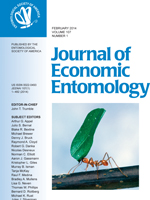Hand removal is often recommended as a method for small-scale control of Japanese beetles (Popillia japonica Newman). In this study, we investigated the effectiveness of daily hand removal for controlling damage by Japanese beetles on grape plants. We also investigated whether the timing of the removal (at 0800, 1400, or 1900 hours, or at all 3 periods) influenced the effectiveness of the technique. We found that hand removal significantly lowered the number of beetles on, and consequently the damage to, grape plants relative to nonremoval controls. Of the single removal treatments, removal of beetles at 1900 hours was most effective, with results similar to removing beetles three times per day. The majority of beetles removed from plants during the experiment were female, a pattern that matches our understanding of aggregation formation behavior in the species, and which may serve to enhance the benefits of hand removal. Hand removal seems to work by decreasing the number of feeding beetles, which in turn reduces the release of aggregation kairomones from the plant, and subsequently decreases the attractiveness of the plant to future beetles.
How to translate text using browser tools
1 February 2014
Effectiveness of Hand Removal for Small-Scale Management of Japanese Beetles (Coleoptera: Scarabaeidae)
Paul V. Switzer,
Ryan M. Cumming
ACCESS THE FULL ARTICLE
It is not available for individual sale.
This article is only available to subscribers.
It is not available for individual sale.
It is not available for individual sale.
aggregation
control
Japanese beetle
management
Popillia japonica





